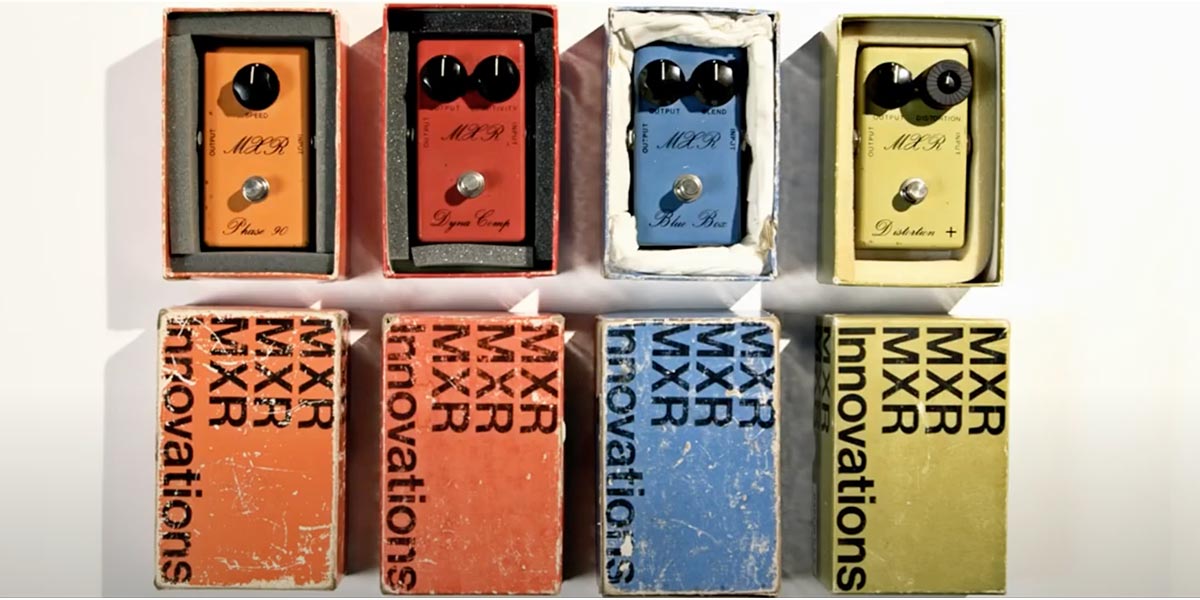
MXR is a popular effects pedal builder for electric guitar and bass guitar. The company was founded in New York in 1972 by Keith Barr, Michael Laiacona and Terry Sherwood.
At the time, Barr and Sherwood had an “Audio Services” sound repair shop in Rochester, New York. They mainly repaired guitar effects and were shocked by the poor quality of the effects that they were offered for repair. This was the reason to start making better and more reliable pedals ourselves. MXR was born and the company created some of the most famous pedals in history.
The first pedal: MXR Phase 90
The very first pedal that MXR released in 1974 was the legendary orange Phase 90. It was a so-called phase shifter, the 90 in the title of the pedal refers to the number of degrees that the signal shifts. The pedal sounded great and was also indestructible. That combination made it (and still is) very popular. The iconic sound of the Phase 90 has become known partly because of Eddie Van Halen. Just listen to the album Van Halen 1 and you can hear it in almost every song.
Rapid success led to more MXR pedals
The rapid success of the Phase 90 didn’t mean that MXR rested on their laurels, as three more famous pedals followed soon after: Distortion +, Dyna Comp Compressor and Blue Box Octave Fuzz. All of these were instant hits and the company suddenly sold thousands upon thousands of pedals all over the world. The pedals were so successful that they were used by virtually all great guitarists, including Jimmy Page, Keith Richards, David Gilmour, Joe Perry, Jerry Garcia, Randy Rhoads and Andy Summers.

Early 80s
The rapid success of the first pedals also quickly disappeared. MXR said goodbye to their successful effects pedals in the early 1980s and instead released larger pedals, including Distortion II, Limiter and Stereo Chorus. The pedals were more expensive than those of the competition (Boss, Ibanez). To compete with this, MXR introduced the micro chorus and micro flanger, among others.
“When I saw the poor quality of the effects devices that were coming in for repair, I was really amazed. Eager to start designing some things, I made up a few little boxes for my guitar-playing friends. They seemed to like them.”
Keith Barr – cofounder MXR (From: Stompbox van Art Thompson – 1997)
MXR went bankrupt
The company also began developing consumer audio products in hopes of expanding its business. In 1984, MXR even discontinued the original pedal line and replaced it with the more affordable 2000 Series pedals, housed in black housings and clearly influenced by those of the competition. Unfortunately, to no avail, in 1984 the company went bankrupt.
The acquisition of MXR by Dunlop Manufacturing
Not long after, Jim Dunlop took over the license rights from MXR. Dunlop recognized the value of the pedals and revived the brand. The first new MXR releases were reissues of the famous Phase 90, Distortion +, Dyna Comp Compressor and Blue Box Octave Fuzz. After that, many new designs would follow. Some of these have become modern classics, including Carbon Copy Analog Delay, Custom Badass ’78 and Uni-Vibe Chorus/Vibrato.

Basspedals and Custom Shop
In addition, Dunlop introduced a Bass Innovations line of pedals especially for bass players. Think of Bass Preamp, Bass Compressor, Bass Envelope Filter, Bass Chorus Deluxe and Bass Octave Deluxe. In addition to bass pedals, there was also a Custom Shop that served as a testing ground for the most ambitious and adventurous ideas.
Current range of guitar pedals
The current range consists of no less than 80 different pedals. MXR has designed a number of pedals with well-known guitarists including Slash, Eddie van Halen and Dimebag Darryl. All pedals are simple to use, indestructible, sound great and have excellent value for money. In short, if you are in the market for a new pedal, take a look at our MXR range. At the moment not all pedals are available yet, the range will be expanded in the coming weeks.
This article uses an article from Guitar World (July 17, 2014) Out of the Box: Guitar World Celebrates the Time-Honored History of MXR Effect Pedals and an article from Dunlop’s website (May 3, 2014) MXR: A short history.
